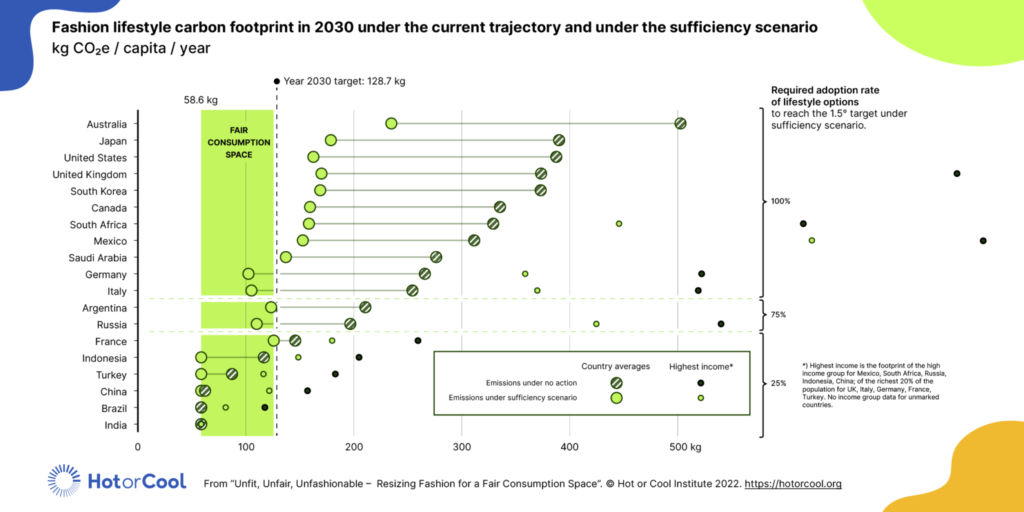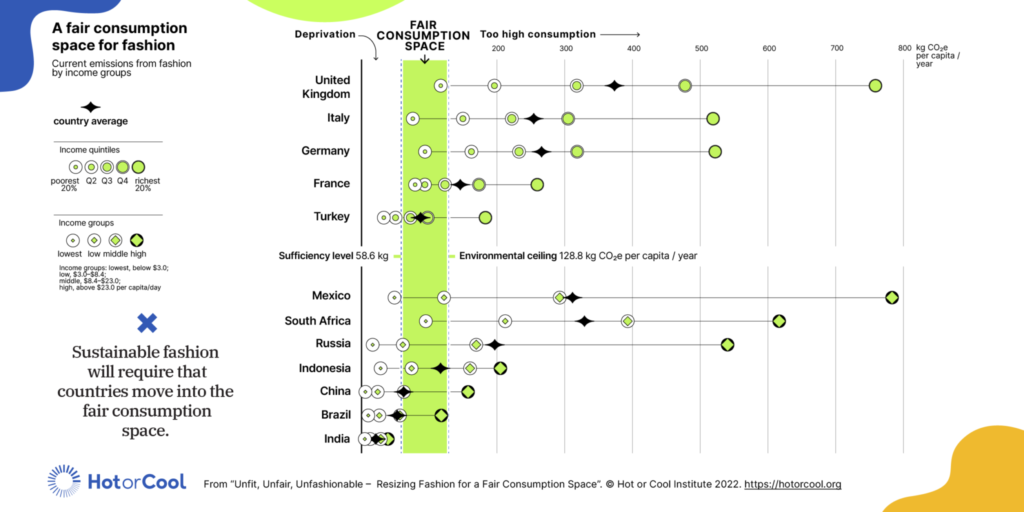As I have gotten more into the topic of the sustainability of fashion, I have found some interesting reports with different takes. This and the next blogpost will summarize and highlight some of the most important finds of two reports. I will also mention how I can use these finds further on.
“Unfit, Unfair, Unfashionable” by Hot or Cool
Hot or Cool’s report “Unfit, Unfair, Unfashionable” showes the divide in consumption between high and low income countries and people. They found that “the richest 20% in the UK emit 83% above the 1.5-target.” At the same time, “74% of people in Indonesia live below sufficiency consumption levels of fashion.” On average the fashion footprint need to be reduced by 2030 by 60% among the high income countries of G20, 40% by the upper-middle income countries while the low income countries are already below the 1.5-degree limit. This divide between high and low income is both clear between countries and within countries.
Within a representative sampling of G20 countries they found that the lowest and second to lowest income quintile is responsible for respectively 6-11% and 10-13%. The second to highest and highest on the other hand is responsible for respectively 24-26% and 36-42%. In simpler words: “On average, the fashion consumption of the richest 20% causes 20 times higher emissions than that of the poorest 20%. This ratio varies substantially across countries, following levels of income inequality.” This debunks the idea that the poor is responsible for the emission because they by “cheap” clothes. They often get blamed in discussion about the emissions of fashion, but it is time that the rich scale down on their consumption.
As reducing the number of purchases of new clothes much (respectively 4 and 3 times) more effective than increasing the use time or (what is considered achievable through) decarbonization of the fashion industry, this should be the focus. (https://hotorcool.org/unfit-unfair-unfashionable/)


In a way this is positive news. Reducing the amount of garments of high income people is a task possible to asses for small companies. This can be done by producing high quality, interesting and lovable pieces that can play many parts in a person’s wardrobe. If we can produce such pieces they can replace the feeling if need of new pieces. The other end, producing lower-emission garments for persons with low income, is a much more complex task. This needs to be assessed by the fast fashion companies and the fashion culture itself. This also needs to be done, but it won’t be as effective as changing the behavior of high income persons.
Another interesting find to consider is that in the UK, Italy and Germany the richest 20% need to reduce their footprint of fashion consumption by respectively 83%, 75% and 75%. However, in the fashion nation France this number is substantially lower, “only” 50% (https://hotorcool.org/unfit-unfair-unfashionable/). This point to the issue that fashion consumption is highly dependent on culture. “French women” is a trademark in fashion, known and praised for using fewer, versatile and timeless pieces instead of indulging in micro and fast trends.
Source:
https://hotorcool.org/unfit-unfair-unfashionable/
Full report:
https://hotorcool.org/wp-content/uploads/2022/12/Hot_or_Cool_1_5_fashion_report_.pdf